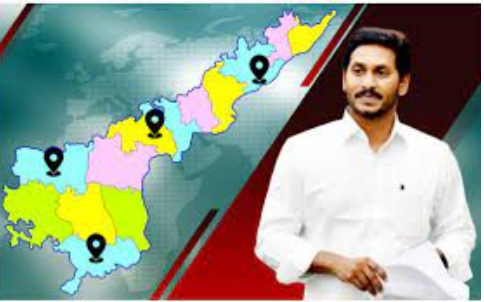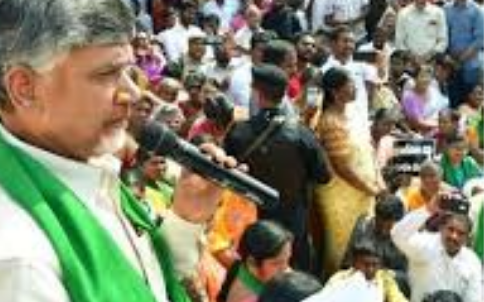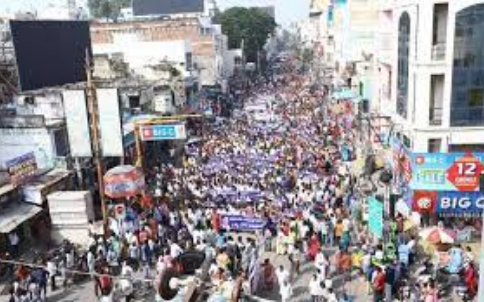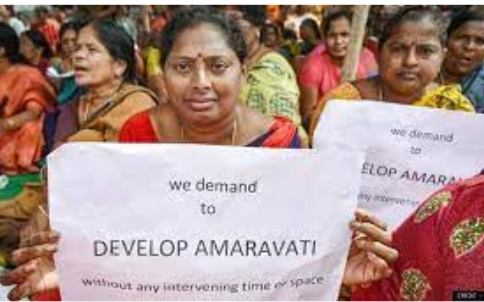The issue of Andhra Pradesh’s capital has even panning in an everlasting dramatic manner since the bifurcation of United Andhra Pradesh in 2014. A historical examination of Andhra’s past reveals the same eternal issues even during the days of the Andhra state in the early 1950s.
Allegations of caste favouritism in selecting a certain city as the capital have been used by all dominant political entities of Andhra Pradesh. The factors of caste-based power play being primary in selecting or even scrapping an existing capital have been crucial in the decisions of various governments post bifurcation. The factors and allegations were the same in the early 1950s in the newly formed Andhra state. The situation was as grim if not more than the current situation. Puchalapalli Sundarayya in a rousing speech in Parliament charged:
“Congress wanted to rouse regional feelings, it wanted to arouse communal feelings, and that is why it selected Kurnool as the capital . . . . The Congress raises the slogan of Reddy vs. Kamma. It says: if you want to change from Kurnool to any centralized place, then Kamma domination will come and Reddy domination will go. These are facts that cannot be controverted by anybody who knows anything about Andhra.”1

A news correspondent in an article in Times of India in1953 openly acknowledged the intense rivalry on the issue of the capital, saying, “In recent years the rivalry between the Reddys of Rayalaseema and rich Kammas of delta districts has grown to alarming proportions. Congressmen have tended to group themselves on communal lines, and the Sanjiva Reddy-Ranga (Gogineni Ranga Nayakulu) tussle for leadership which finally resulted in Ranga’s exit from the Congress is a major instance in this regard. And
rightly or wrongly the choice of Kurnool is looked upon by the Kammas as another major triumph for Reddys.”
Tussle between Reddys and Kammas
The battle lines between the dominant political, social, and economical groups of Kammas and Reddies cut across party lines, within the Congress itself being consolidated into caste groups, while the Communist party stood as a strong antithesis to Congress as a Kamma stronghold in the delta region. Tensions were high starting from the APCC election in 1951, when TanguturiPrakasam Panthulu (who was previously pushed out of the APCC Post because he was a Brahmin in 1937) tried to fight out NeelamSanjeeva Reddy who was backed by the feudal Reddy lobby by pitching for NG Ranga, an intellectual veteran against Reddy. Prakasam by bringing in NG Ranga, whose victory would ensure Kammas and their political, economical, and social support would turn to the Congress as well to ensure a strict check on Sanjiva Reddy, his rival.3
But NG Ranga though backed by a veteran like Prakasam who was also the Chief Minister of the State at that time lost to Sanjiva Reddy. His defeat was largely due to the efforts of the feudal Reddy lobby, particularly of the Rayalaseema region, who naturally backed Neelam Sanjiva Reddy over Ranga.

This not only turned away the Kammas from Congress and more towards the Communist party in the Delta region, but also began flaring up tensions between the two groups. A huge Kamma deflection from Congress ensured in 1951. These tensions were intense till the 1956 inception of United Andhra Pradesh.
Kurnool as capital
After the creation of Andhra state, the dominant Reddy lobby pitched for Kurnool as the capital. Though Prakasam was the Chief Minister of the State, the party now being divided on clear caste lines of Reddy lobby v Kamma and Brahmin lobby, with the upper hand being that of the Reddy lobby. The official justification by the party and its leaders who favoured Kurnool was that the Sribagh Pact (made in 1937 by leaders of the Andhra region and Rayalaseema region to ensure equality to Rayalaseema post its merger with Andhra) compelled them to select Kurnool as the capital as it would ensure development for the Rayalaseema region. But this controversial decision, received scathing criticism from Kammas within the Congress as well as the Communists as naturally excepted. The crucial factor in selecting Kurnool as capital and opposition to it as well was caste. Kurnool was in a Reddy stronghold of Rayalaseema and not the Krishna-Guntur delta region which was a stronghold of Kammas and Brahmins.4

Bezawada Gopala Reddy becomes CM
Soon, Prakasam’s government fell within a year necessitating mid-term elections. Nehru fearing a large Kamma deflection like in 1951, and an upper hand for the Communists. called up Prakasam, NG Ranga and Neelam Sanjiva Reddy for peace, encouraging them to draft a united election plan against Communists. Though Sanjiva Reddy loathed working with NG Ranga, it was a necessity to fight against Communists. NG Ranga as the scion of the Kammas, did his best to gather large economical, political, and social support from Kammas who were largely Communist by then. Even then, at large pockets, Ranga was able to generate support for Congress from Kamma community in the Delta region, with many Kammas winning on Congress tickets. The election ended in a resounding victory for the Reddys, with Bezawada Gopala Reddy becoming the Chief Minister. The caste war on the issue of Andhra’s capital remained unresolved.5
In the successive years leading to the inception of United Andhra Pradesh, and the move to Hyderabad as capital, new caste equations and battles in Telugu politics emerged with Telangana’s caste dialectics complicating the equation further.
History clearly shows that it may be then or it may be now. The issue of caste is crucial if not a primary motivating factor for the selection of Andhra’s capital. When will that not be a factor? Perhaps when our democracy gets mature with a change in the voter’s psyche. Until then, this eternal battle of castes for power goes on in the Telugu land.
References:
1. “We Demand Free and Fair Elections,” Parliament speech by P. Sundarayya, cited in For Victory in Andhra, CPI publication (Delhi, 1955), p. 13.
2. Times of India (Bombay), June 16, 1953, p. 7.
3. Andhra Kesari Tanguturi Prakasam- Lok Sabha Secretariat- May 2000 p.18
4 & 5. CASTE AND THE ANDHRA COMMUNISTS- University of California, Berkeley- American Political Review-Journal by SELIG S. HARRISON – p. 398- 400.





True to a large extent. When NTR tried to develop Vijayawada, bigwigs from Kamma community were said to have diluted his plans. Kammas have an inherent fear that development will deprive them of their supremacy in the region. They have good risk taking ability and hardworking nature. They should develop Vijayawada and invite all strata of society. Similarly Reddys too restrict themselves to their region. When AP was formed they started moving to Hyderabad, perhaps, as Reddys have sizable strength in Telangana region.
By and large caste equations dominate politics in AP like any other state in India